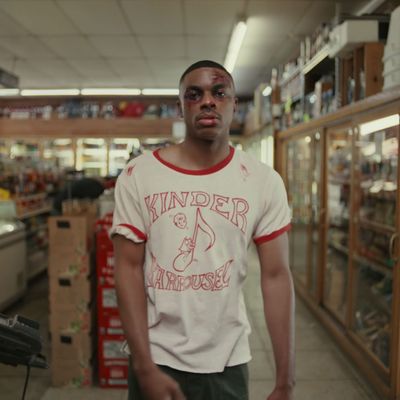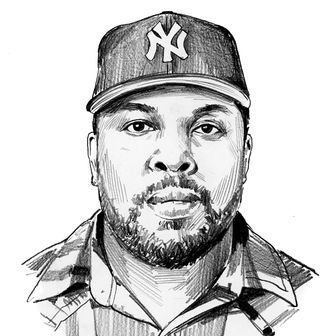
The histrionics about the Oscars last month were a poignant reminder that some people see violence as a looming, existential threat on the march from far away, and some people live in the numb inevitability of it. Like, duh, try not to hit anyone at the premier gala in your profession. But playing it off as unconscionable behavior was an odd choice. It wasn’t even the tenth-wildest story in Los Angeles that week. The Friday before the show, a man died in South L.A. after being hit by a car while he sought assistance for gunshot wounds sustained moments earlier as he was robbed in broad daylight. Sunday night, during the Oscar broadcast, a dispute near an East L.A. food cart erupted in gunfire, killing one. Americans have a paradoxical relationship with violence. We’re titillated by documentaries about serial killers, creative scammers, and historical atrocities, but conversations about crime often break down because the people furthest from it and the people most directly affected by it often have very different ideas about the nature of the threat. In the last presidential election we saw suburban voters whipped into a frenzy over hypothetical depravity following the protests of 2020. Living in the cities in question at the time, you caught vile, indelible moments of law-enforcement overreach and brutality. But city residents are every bit as susceptible to scaremongering. We have seen affluent New Yorkers try to stop the city from moving unhoused citizens into vacant hotel rooms during the early pandemic, we have seen people sensationalize shoplifting in San Francisco, and we have now seen rich Angelenos regaling us with elaborate murder fantasies over a guy getting smacked in the face. In the meantime, billion-dollar police departments have enough surplus to donate to Ukraine; if you live in a neighborhood where gunshots aren’t uncommon, the influx of funding hasn’t made you that much safer.
The video for Vince Staples’s new single “Magic” is a testament to how easily a day can go to hell over a minor dispute in the America where physical danger is as real of a daily consideration as the weather. In the two-and-a-half-minute clip, the Long Beach rapper makes an appearance at a house party where he bumps into another reveler’s arm, tripping off a disagreement that ends with the rapper being stomped out by a group and stumbling to a convenience store to secure a bag of ice for his bloody face. Vince’s videos often play out this way. They’re compact horror stories with unexpected twists. They lure you into a sense of comfort they gleefully snatch away. You see Vince glaring out of an open car window at the beginning of the video for “Norf Norf” from 2015’s Summertime ’06, and you wonder where he’s heading until the camera pans out to reveal a police-car siren overhead. The video for Summertime’s “Señorita” surveys scenes of inner-city chaos before pulling back to reveal a white family watching the footage in a museum. “Law of Averages” from last summer’s Vince Staples starts with a tailgate party and ends with the revelers lying on the ground, seemingly dead. The same album’s “Are You With That?” is set to a scene where the artist is slowly chased by a car that runs him over. Vince Staples wants you to know how easy it is to die in America in the shadow of the intersecting codes that govern the streets, amid the territorial scuffles of gang life and the ease of a terrible experience with the police. The off-putting juxtaposition of beauty and danger in the visual element of Vince’s work examines the dualities of Southern California, where it rarely rains but you still run the risk of getting wet up. This is Cali music tradition, not so far removed from the balance of murder raps and slick grooves at the root of G-funk, or the sweet-sounding terror of psych rock.
As much as songs like “Blue Suede” and “Hands Up” tell us that Staples understands Cali rap convention, the catalogue often seems to be in conflict with the expectation of adherence to a sound closely tied to the rapper’s home state. The taut, minimal beats on Summertime came as a shock after the more traditional gangsta-rap vibe of 2014’s Hell Can Wait EP. On 2017’s Big Fish Theory, Vince pivoted to coarse, edgy dance music and divided the fandom. (Or so the logic goes. Big Fish is, at present, the best-selling album in his catalogue. Since no one else thought to get Kendrick Lamar rapping on a SOPHIE beat, we’re going to call it a win.) A year later, FM! eased off the abrasiveness of Big Fish, breezing through micro-genres at dizzying speeds, like a radio playlist finding a way to fit appearances from Earl Sweatshirt and Tyga into the same segment. Last summer’s self-titled drafted Kenny Beats for a slicker, more commercial sound, making excellent use of the Connecticut-born producer’s knack for lean, bubbly hooks and smart sample work, but that went over weirdly, too, for some reason, as Vince addressed complaints about the album on Twitter. No one knows what they want from a Vince Staples album. He doesn’t care to placate us anyhow.
After throwing listeners for a loop with each of his first four projects, Vince Staples surprises us again with a fifth, this spring’s Ramona Park Broke My Heart, an album steeped in West Coast traditions. If you listen carefully and eyeball the credits, you’ll catch appearances from and allusions to a wealth of hip-hop and street-life legends. “DJ Quik” pays homage to the rapper-producer’s 1995 gem “Dollaz + Sense” and calls him in for scratches. “Papercuts” references 2Pac’s “Picture Me Rolling” over a beat by TDE regular DJ Dahi. The breezy Ty Dolla $ign collab “Lemonade” mentions Schoolboy Q and Pomona rap icon Suga Free. “Bang That” and “Magic” employ the signature bounce of Mustard; the latter uses the same slice of R&B star Evelyn “Champagne” King’s 1977 jam “The Show Is Over” that Quincy Jones’s son QDIII flipped for Ice Cube’s “You Know How We Do It,” off of 1993’s Lethal Injection. The interludes pull from reports about Cali gang violence in the ’90s: “The Spirit of Monster Kody” cedes the floor to the legendary Crip whose 1993 autobiography became an unexpected best seller, while “Nameless” samples dialogue from a ’90s episode of The History Channel’s 20th Century With Mike Wallace, where a news reporter tries to shame the late Compton Piru Sylvia “Rambo” Nunn but instead gets treated to an eloquent assessment of all the factors drawing people into the life in the first place. (The album isn’t only drawing from Cali rap influences. “Rose Street” carries a faint whiff of Mýa and Jay-Z’s “Best of Me, Part 2.” “When Sparks Fly” pulls drums from Mobb Deep’s “More Trife Life.”) Ramona Park Broke My Heart is a careful balancing act, a love letter to street life that doesn’t slouch on honest discussion of the trouble that can come with gang affiliations, a modern West Coast rap album trying to wrap its arms around three decades of hip-hop history, a Universal Music Group release that feels calculatedly commercial without ever sounding gimmicky or airheaded.
Death is the only certainty throughout Ramona Park Broke My Heart. In a single verse, “The Beach” sets a bleak scene early, cleverly summarizing the good and bad ways of making it out of Long Beach: “In the city, baby, your first rap can be a murder rap.” The storytelling is pointed and unrelenting, full of detailed descriptions of precisely what can happen if you get caught outside lacking. You think that “Aye! (Free the Homies)” — which samples the “Free the Homies” interlude from Compton rapper YG’s 2018 album Stay Dangerous — is going to be a song like 2Pac’s “Life Goes On,” where lost friends are mourned and living ones are pulled in close, and then Vince threatens to shoot your mother in the first line. You think “When Sparks Fly” is a song about a forbidden romance until the second verse makes it increasingly clear that the love interest in these verses is a gun. “Sparks” is another classic full-song double entendre in the spirit of Common’s “I Used to Love H.E.R.” The genius trick is making you think the images in these verses are flowery metaphors — “Love how you illuminate my thoughts” — when they’re really literal descriptions of a gun being discharged, confiscated, and bagged up as evidence. The pen game is frequently this chilling. “Slide” takes you out banging and leaves you with an eerily matter-of-fact assessment of what a shooter sees mid-murder: “It’s a wrap, hit his lungs if he run / Hit his back, if he crawl, hit his hat.” Ramona Park doesn’t let up even when the hooks sweeten up. Tapping into the bounce of 2010s jams like Dolla $ign’s “Paranoid” on “Lemonade,” Vince croons darkly: “I come from where everybody thirsty / Got some money, now these n- - - - - wanna hurt me.” Over the smooth “Papercuts,” Vince muses on mourning and mortality: “If I went and died today, who’d remember me? / Just keep it real with me, I don’t need no sympathy.”
Ramona Park Broke My Heart surveys cycles of violence and the people who are pushed to perpetuate them, because of pride or neighborhood affiliations or fear or simple adherence to long-standing tradition. It’s not intellectualizing these issues for you so much as it is smashing your face into them, shoving you into the seat of the museum spectators in the “Señorita” video. It if wasn’t completely apparent from that moment that Vince Staples gets a kick out of poking a finger into the white gaze in the same way the new season of Atlanta depicts a series of catastrophes that start with white guilt, check the interview he gave to Hot 97’s Peter Rosenberg last month where he criticized major labels for coldly profiting off the deaths of rappers: “The album ready in four weeks once you die.” The causality between real and fictionalized violence is as prickly a subject today as it was in the ’90s when Americans, equally intrigued and scandalized by gang violence, argued about the morality of gangsta rap while Monster Kody’s book took off, Dr. Dre’s The Chronic sold millions, and John Singleton made history as the first Black man ever nominated for the Academy Award for Best Director for Boyz N the Hood. If there’s a message in all of the deadpanned horror of Ramona Park Broke My Heart, it’s the care in cherry-picking of voices from different gangs and successive generations. It creates a picture of a problem that predates us and will, at the rate things are going, certainly outlast us. As a nation, we remain overly reliant on carceral solutions that have not panned out as easy fixes. Everybody thinks they know what should happen after a violent act occurs. There aren’t so many clever ideas about how to curtail the conflicts that feed it. So the cycle continues.


